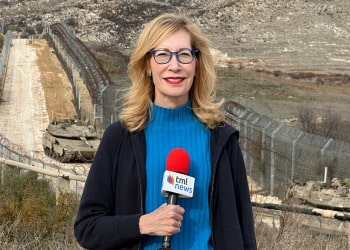Some Lebanese Flee to Neighboring Syria To Escape Potential War
Historically, Lebanese citizens have sought refuge in Syrian territory, but after the start of the civil war, this migration pattern changed
[Beirut] History has shown that desperate times call for desperate measures. Since the start of the Israel-Hamas war in Gaza, some Lebanese have been experiencing conflict firsthand in Lebanon. With the fear of an expanded war levitating over their heads for months, a few Lebanese have decided to look for safety outside the borders of their country, though not too far away. Despite the more-than-a-decade-long civil war in neighboring Syria, some Lebanese families have decided to flee there.
After the attack at the end of July in Beirut’s southern suburb of Dahiyeh, which killed a top Hezbollah commander, two children, and three women, many residents felt the urgency to think of a way out. More than 11 months of confrontation between the armed Shia group Hezbollah and the Israeli army on the Lebanese-Israeli border has caused the displacement of around 100,000 people living in these border villages. Some have sought shelter with family members, and others have crowded into schools, where they are still seeking refuge.
Though it’s not a mass migration pattern, some Lebanese individuals, particularly those with business or familial ties in Syria, still cross the border.
“Though it’s not a mass migration pattern, some Lebanese individuals, particularly those with business or familial ties in Syria, still cross the border,” Jasmin Lilian Diab, director of the Institute for Migration Studies at the Lebanese American University, told The Media Line.
Researchers overseen by Dr. Diab and quoted by the Associated Press found out that 80 people displaced from southern Lebanon now live in greater Beirut. These include Lebanese, Syrians, and Palestinian refugees; at least 20 said they were considering taking refuge in Syria if the war in Lebanon escalates.
Despite the threats of extending into a greater regional war, Syria has stood on the sidelines of the current conflict between Israel, Hamas, and Hezbollah. The surprise Hamas attack on October 7 killed around 1,200 Israelis, and the brutal military response by Israel has already destroyed most of the Gaza Strip, reportedly killing around 41,000 Palestinians. Regional actors such as Hezbollah and the Yemeni Houthis have shown solidarity with Hamas and the Palestinian suffering, launching attacks to weaken Israel. But Syrian President Bashar al-Assad’s government has chosen to ignore the continuous Israeli airstrikes on its territory; these attacks usually target Iranian-linked military sites or fighters.
Syria is still recovering from the aftermath of its civil war, and large parts of the country remain insecure or underdeveloped, making it an unviable option for refuge.
This holiday season, give to:
Truth and understanding
The Media Line's intrepid correspondents are in Israel, Gaza, Lebanon, Syria and Pakistan providing first-person reporting.
They all said they cover it.
We see it.
We report with just one agenda: the truth.
Please support TML's boots on the ground.Donate

The fact that Syria is not actively participating in the conflict makes it more attractive for desperate Lebanese refugees. “Syria is still recovering from the aftermath of its civil war, and large parts of the country remain insecure or underdeveloped, making it an unviable option for refuge,” Dr. Diab said. There is not a clear number of how many Lebanese have ignored these risks and have considered that living in a warzone in Syria might be safer than living in a warzone in Lebanon. These Lebanese in Syria are not registered as refugees, and they are spread across the country, which makes calculating their numbers almost impossible.
“Most of the people I know that have chosen to flee to Syria already had some ties there,” an anonymous Shia Lebanese told The Media Line. “I don’t think it is the best place to go right now,” he added after confessing that he is not afraid. “Lebanese are used to the wars,” he said, adding that in the past, this migration route was more relevant.
“Lebanese society has fled to Syria at various points in history, most notably during times of civil strife and war in Lebanon,” said Dr. Diab.
History proves it. “The Lebanese Civil War between 1975 and 1990 saw many Lebanese, especially those in border regions, seek refuge in Syria due to the violence and instability in Lebanon,” Dr. Diab explained. “Additionally, during the 2006 Israel-Hezbollah war, a number of Lebanese sought temporary refuge in Syria as Israel bombed parts of Lebanon, particularly in the south and the suburbs of Beirut,” she added.
In 2006, some 180,000 Lebanese took refuge in Syria. The more privileged refugees rented houses, but the majority had to take shelter in schools, mosques and empty factories. “The Syrian civil war, which began in 2011, significantly altered the dynamics of migration between the two countries,” Dr. Diab said. “Rather than Lebanese citizens fleeing to Syria, it was Syrians who fled from the conflict in their country, with over a million crossing into Lebanon; the Syrian war destabilized the region and transformed Syria from a potential refuge for Lebanese to a major source of refugees itself,” the director of the Institute for Migration Studies added.
While the recent escalations along the Lebanon-Israel border have raised concerns, Syria is not viewed as a safe or desirable destination for Lebanese seeking refuge; the situation in Syria is still fragile, with ongoing insecurity, and many Lebanese are more likely to experience internal displacement or attempt to seek refuge in countries outside the region.
“The conflict also closed off many traditional migration routes and made cross-border movement much more dangerous,” Dr. Diab pointed out. Despite rent being cheaper and having easier access since they don’t pay for visas, many Lebanese still think twice before making the move to Syria.
“While the recent escalations along the Lebanon-Israel border have raised concerns, Syria is not viewed as a safe or desirable destination for Lebanese seeking refuge; the situation in Syria is still fragile, with ongoing insecurity, and many Lebanese are more likely to experience internal displacement or attempt to seek refuge in countries outside the region,” Dr. Diab added.
Throughout these 11 months of military confrontation, many Syrians have been trapped in between the fights in Lebanon and some have been killed as a result. In July, three Syrian children were killed by an Israeli attack when they were reportedly playing outside their home in south Lebanon. Their parents fled a war to have their kids killed in another one. “Some Syrians in Lebanon are contemplating returning to Syria, often due to the harsh living conditions in Lebanon, including economic hardship, xenophobia, and legal challenges,” Dr. Diab said.
“However, returning to Syria carries significant risks for many: those associated with opposition groups, draft-eligible men, or individuals who fled regime-controlled areas may face persecution, arrest, or forced conscription upon their return,” the Lebanese researcher said.
“The infrastructure in many parts of Syria is also still severely damaged, and access to basic services remains limited, making return an uncertain and potentially dangerous option for many Syrians,” Dr. Diab concluded.

